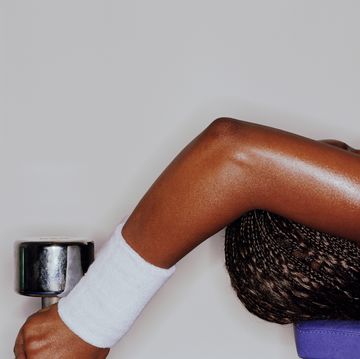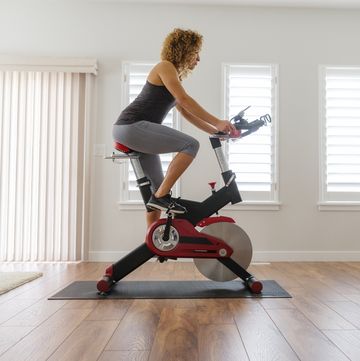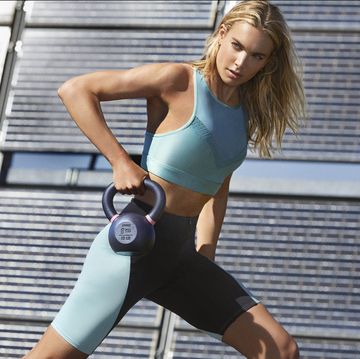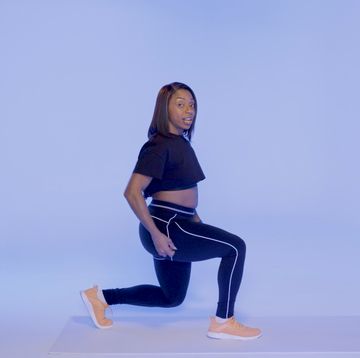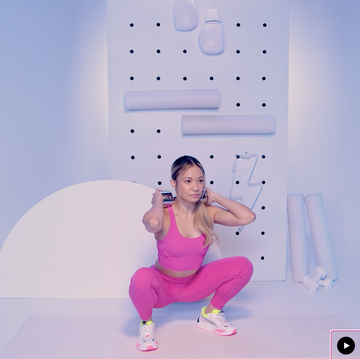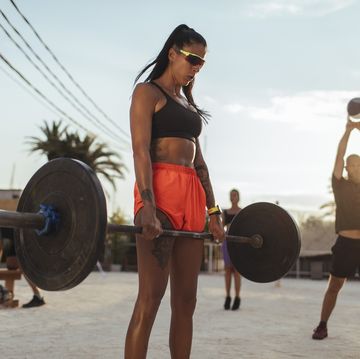If you've ever heard a fitness instructor use a phrase in class that makes you think 'WTF does that mean?!', it's not just you. There are plenty of cues in heavy circulation that, let's face it, just aren't that great.
The problem is that not all instructional phrases say what they actually mean—or should mean, at least. Some are ineffective because they aren't worded very well; others are just plain wrong.
Plus, when you've heard cues like "keep your chest up" and "squeeze your shoulders together" a hundred times, they can start to sound like white noise. But instead of ignoring them or assuming you've got it down, it's important to make sure you understand what these phrases are actually getting at. Because, after all, when it comes to seeing the results, an exercise is only as good as the form you're using.
To get the most out of every squat, pullup, and plank, here are nine commonly-used phrases you should think twice about, along with what you should really be doing.
Translation: "Set your hips back before you bend your knees."
This is one of the most common squat and lunge form notes in the book, but as it turns out, there's nothing inherently bad about letting your knees go past your toes. "I appreciate where people are coming from [with this cue], but rather than focusing on where your knees are going, you should focus on setting your hips back and loading through your glutes," says exercise physiologist Joel Seedman, Ph.D., owner of Advanced Human Performance in Atlanta, Georgia. So, really, the goal is to hinge forward at your hips and set them back before you bend your knees (this order is key). That way your butt and hamstrings are doing most of the work instead of your quads.
Hinging your hips and using your glutes often means that your knees naturally won't go over your toes, but if they still do, it's NBD—bodies are built differently. "As human beings moving around in life, our knees can go past our toes. It's natural," says Jennifer Leah Gottlieb, NASM certified personal trainer and founder of JLG Fitness.
(Torch fat, get fit, and look and feel great with Women's Health's All in 18 DVD!)
Translation: "Keep your spine and head neutral."
This tip was originally designed to keep people from hunching over during squatting movements, but trying to keep your upper body perfectly vertical can over-correct the problem. When your chest and head are too far up, your hips follow, so you can't sit back and work your glutes and hamstrings, explains Seedman. When you hinge at your hips to do a squat or lunge, you should actually be leaning slightly forward and gazing at the floor at about a 45-degree angle, he says, while still keeping your upper body in one straight line.
"You'll have much better glute activation and get stress off your knees and spine," says Seedman. Plus, you'll get more core action in, rather than excessively activating your spine (which is what happens when you're straight up), he adds.
Tight on time? This quickie workout will help you squeeze in some exercise:
Translation: "Take a stance that feels comfortable."
Whether your feet are hip-width distance apart, slightly more narrow, or slightly wider, you're still going to get the same benefits from a squat, says Seedman. "What we want for the individual is to take a stance that feels comfortable and strong," he says. "That's going to vary from person to person. I generally start someone off around shoulder-width and I'll let them play with that based on what feel natural."
Related: 5 Arm Moves That Use Little Weights For BIG Results
Translation: "Try to line up the bar with your upper chest."
If you're working on your pullup game (congrats!), beware of this common phrase.
"When you're doing a pullup, you don't want to reach with your chin," says Seedman. "What you want to focus on is keeping your chest out and almost leaning away from the bar." When you try to pull yourself too close to the bar, you end up flexing your neck and rounding your shoulders, which is setting yourself up for pain and injury.
Instead, he says you should try to line the bar up with your upper chest. Another way to think about it is raising your ribcage toward the bar, adds Gottlieb.
Translation: "Focus on working from your back."
This cue is aimed at getting you to work your back muscles in exercises like rows and flys. But when you go past your range of motion by trying to squeeze your shoulder blades together, you actually disengage the lat muscles in your back and put your shoulders in an unstable position while stressing your neck, says Seedman.
"Instead of squeezing the shoulder blades together, what I cue is keep your chest out and keep your shoulders back, but they don't have to necessarily be squeezed together," says Seedman. Pull your arms back until you feel your back muscles engage, and that should be your natural stopping point. Rather than driving your shoulder blades together, focus on using your back muscles to power the movement.
Related: This Is How The Fittest People On Earth REALLY Work Out
Translation: "Engage your legs."
This is one of those cues that's actually just incorrect, explains Seedman. "If you think about getting into a pushup or a plank position, gravity wants to push you down toward the floor. So why would we want to squeeze the glutes and contribute to that stress?" he says. Squeezing your glutes pushes you closer to the floor instead of lifting you away from it.
"This cue is used to encourage people not to stick their butts out or 'cheat,' but it’s better to think of squeezing the quads and firing the hip flexors," says Gottlieb. Think about it like engaging your legs.
Translation: "Rest your head in your hands."
While yes, it is important to avoid pulling on your neck during abs exercises, rather than trying not to put the weight of your head in your hands (which can create more stress), just rest your head in your hands, says Ashley Borden, IFA certified trainer (who works with celeb clients like Mandy Moore, Reese Witherspoon, and Ryan Gosling).
"Your head should be completely relaxed in your hands," she explains. With your hands interlaced, your thumbs should be right around your hairline—not so high up that it pulls your head forward, and not so low that your head falls back.
Translation: "Keep your feet slightly turned out."
For most people, keeping your toes pointing forward "causes the ball that is inside our hip socket to 'knock' on the hip socket wall, which stops the hips from moving," explains Gottlieb. This often forces your lower back to do more work, and prevents you from reaching your full range of motion in a squat.
To get an idea of where your feet should be, make a thumbs-up in front you with both hands and move them down to your hip bones. Where your thumbs point is a starting point for where your feet should be angled, says Borden.
Related: These Are The 4 Best Leg Exercises For People Who Want To See Serious Results
Translation: "Focus on how you feel."
This can be tricky when it's right in front of you, but try not to focus on a mirror the whole time you're working out. " Watching yourself in the mirror takes you out of your body," says Borden. Instead, check yourself out for a couple reps to look at your form, then focus your attention on moving correctly through the exercise (instead of just watching it happening). If you can, Borden says try to film yourself doing an exercise so you can look at your form afterwards, too. "That's why professional athletes watch game tape," she says.
Alexa is a Denver-based contributor who covers all things lifestyle, wellness, travel, home, and beauty. When she's not writing, you can find her sweating it out at boxing or Pilates, planning her next travel adventure, or drinking red wine.




